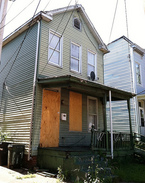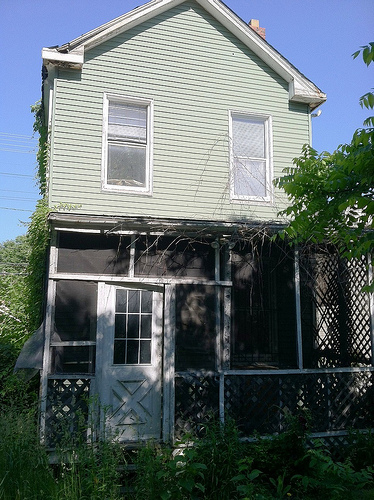100-year old Anacostia abandominium houses crack addict
Don’t be misled. The plywood that covers the front door and one of two front windows of 2010 14th Street SE, a 100-year old home in Historic Anacostia, belies the wide open rear entrance from which drug users come and go with impunity.
When George W. Thompson, who bought the house in 1969, died many years ago, his wife, Marie, was also dead. His will left the house to his daughter, who reportedly died soon thereafter. No one emerged to claim the house.
Until DC’s Water and Sewer Authority filed a lien against Thompson in the fall of 2009, no one paid the house much mind except the husband of Thompson’s deceased daughter, who according to multiple sources in the neighborhood has been squatting in the house for years.
“Yeah, a former associate of mine has been set up in there pretty tight for a number of years,” said community activist William Alston-El, who through community work and life experiences is affiliated with Anacostia’s underworld. “His wife died and that’s when he started. He’s on crack, he’s pretty gone in the head, you know. Yeah, you could say it’s a crack house abandominium, a lot of people have been up in there, you know what I mean?”
By 2011 the taxes grew to more than $3,000. At this time Redemptor Litium, LLC, with holdings throughout all city neighborhoods, purchased the lien.
“This is a typical law school exam question,” says James M. Loots, the lawyer representing Redemptor Litium, LLC. “The tax sale is supposed to fix the problem of getting the property under control and back to contributing property taxes.”
Loots says his client has filed a motion for judgment and followed every necessary step to receive an order of foreclosure from posting the mandatory orange notice on the front door, to searching for heirs in the probate docket, to advertising in the paper for all known and unknown heirs to come forth.
The case is on a judge’s desk and awaits another status hearing scheduled for next month.
Unfriendly neighbor
Dewey Sampson lives next door to the crack house abandominium. A federal employee, Sampson bought his home a little less than two years ago. On move-in day, two men sitting out front of the house next door offered their help, as good neighbors. Sampson soon learned from a long-time resident two down over that the men didn’t live there. Nobody does. They are known undesirables, squatters.
“Early last summer I saw the orange sticker posted on the door,” Sampson said. “I was really excited. I thought something was going to happen, but I didn’t think it would take this long.”
After the posting, last fall Sampson called the police on two squatters, who after an evening of drinking and drugging were cursing at each other loud enough for Sampson to hear through his walls.
“The police came right away. When they took one of the guys away he kept yelling, ‘This is my house! This is my house! I was like what is he talking about?” said Sampson.
After telling him what I’d heard from Alston-El, Sampson said it now made sense. What’s still illogical to Sampson and his fiance is how the house could sit vacant for so many years.
“This is a paradigm example of what the tax sale process is designed to address — getting vacant or neglected properties back on the tax rolls and into productive use. Unfortunately, that process takes a very long time,” said Loots.
The sooner the better for Sampson, who last week saw a face he’d never seen before leaving the back of the house. “I don’t want to judge people, but she looked like she was on drugs.” Adding insult to injury, Sampson just paid an exterminator as a result of termites coming over from the abandominium.
“Those guys coming and going primarily are a safety concern for my fiancé, me, and the entire neighborhood. What if they set the house on fire and it spreads?” Sampson said. “What do we do then?”
Inside the house
This past Sunday morning with iPhone in hand, I went around to back of the home. Although the city boarded up the front door and the adjacent window last fall, I saw no evidence that anyone has made an effort to secure the rear.
I opened the mesh-screened back porch easily. There were bars on the back porch window to stop intruders from climbing in, but the back door is wide open.
Stepping inside the kitchen, the rancid smell of urine welcomed me. The counter was covered in stubs of used candles and empty cans of Goya beans. The floor was littered with all sorts of debris, including chunks of fallen plaster from the ceiling. Slices of light from the second floor peeked through through small gaps in the floorboards above.
In the living room, more clothes covered the floor, along with discarded syringes and a bent spoon used to fire up dope. Two windows fronted 14th Street, one boarded up, one deflecting the morning sun behind a thick curtain. Peeling back the curtain, I saw Engine Company Fifteen; down the street is Saint Phillip the Evangelist Episcopal Church; in the median sits the restored Old Market House Square, which had a ribbon cutting last fall.
In the tight hallway junk mail fertilizes the floor. Three framed pictures rest atop the radiator: a baby girl not yet pre-school aged, a young man flashing a smile in cap and gown, and repentant hands coming together in a moment of prayer. Lord knows the rebirth of Historic Anacostia’s crumbling homes need communion through any and all lines of invocation. Underneath the three photos is an unread Washington Post from this past November.
I ascended the staircase, keeping my ears open for any sounds of rustling. At the head of the stairs is a small room, the door ajar. A bare mattress sat snug in the far corner, amid fallen sheetrock and plaster. Behind the door I saw dress shirts and suits. I walk back into the hall and past the bathroom with the upturned bathtub and toilet laying on its side.
In the far room, Clothes strewn everywhere, a king size bed headboard sans bed, a plastic lawn chair, a DirecTV remote with no television to control. Running up in the home alone, without the better company of a friend, I feel I should get going.
Passing a closed green door, I heard the static of a raspy cough. Time to get ghost. I slipped down the stairs, knowing the man behind the green door will not pursue what he likely thinks is a fellow squatter just looking for a small poor man’s piece of the rock, an abandominium.
Over debris, clothes, beer cans, and drug paraphernalia I passed through the living room, crouched under a long board that’s presumably been set up as a barrier between the kitchen and further entryway into the abandominium for a less able-bodied person. My first and last self-guided tour of an Anacostia abandominium.
I give Alston-El a call, telling him what I saw.
“What’s the waiting list for housing in this city, 45,000? Me and you could find that many units and more in all these abandominiums,” Alston-El says. A painter-by-trade, Alston-El repeats his lament, “They fix these places up and then there’d be jobs for everyone from the community who can work with their hands. It could create some small businesses. Yeah, but they don’t want to do that, you see, because it would save the neighborhood. But, nope, too much like right.”



